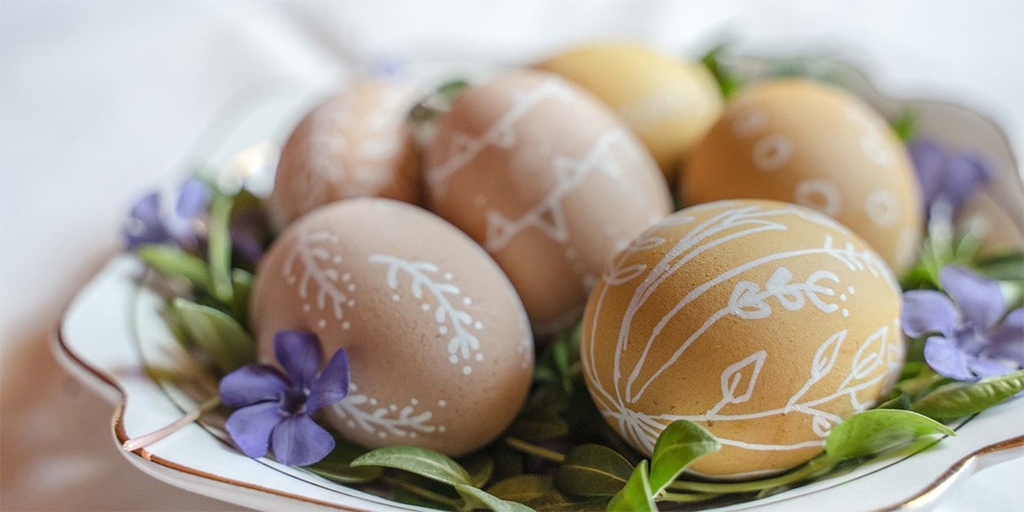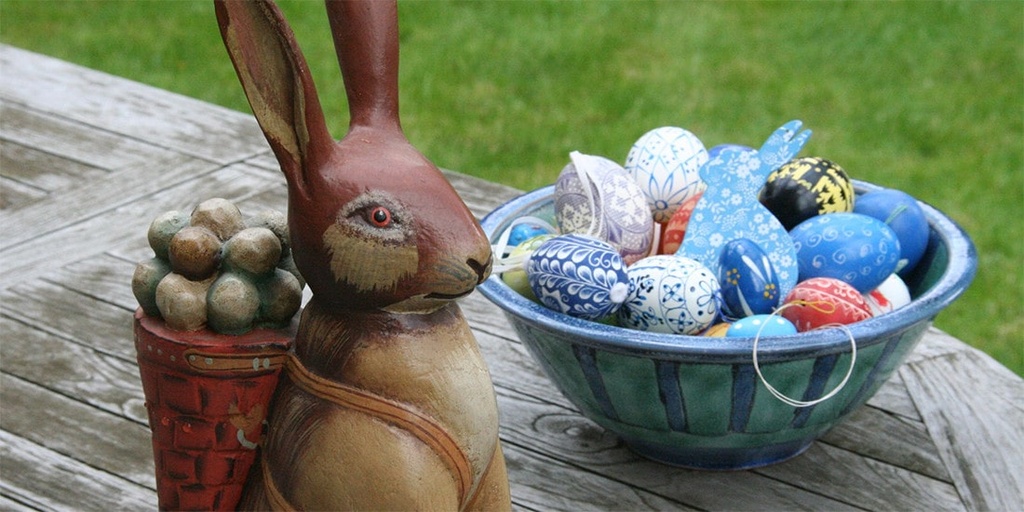Decorate eggs with natural dyes

Earth Points1 




EaseMedium
Summary
Did you know that food coloring is often derived from petroleum? Not only is it bad for the environment, it is also not great for our health. When dying eggs this spring, opt for natural alternatives.
Description
Humans have been decorating eggs for thousands of years to celebrate the start of spring. Make your Easter eggs special and unique this year by dying them yourself using natural dyes rather than synthetic.
Why use natural dyes instead of food coloring? Food coloring is actually derived from petroleum, it causes environmental damage where it is produced, and it can cause allergic reactions and even hyperactivity in some children. The risk may be low for most people, but the eco-friendly alternative is to use natural ingredients and items you may already have in your home to decorate your Easter eggs.
Why use natural dyes instead of food coloring? Food coloring is actually derived from petroleum, it causes environmental damage where it is produced, and it can cause allergic reactions and even hyperactivity in some children. The risk may be low for most people, but the eco-friendly alternative is to use natural ingredients and items you may already have in your home to decorate your Easter eggs.
Tips
Here are some ideas to try out natural dyes.
Materials
• A pot
• Eggs
• Whisk
• Small bowls
• Tongs
• Paper or cloth towels
• Vinegar
Ingredients to make the dyes (dyeing agents). Note: Some ingredients are listed for multiple colors. This is because the ingredients produce different colors based on how they are prepared and how long the eggs soak in the solution.
• Red — Beets, paprika, cranberries, raspberries
• Pink — Beets, turmeric, onion skins
• Orange — Yellow onion skins, saffron, chili powder
• Yellow — Turmeric, carrots, orange peels, lemon peels
• Green — Turmeric, red onions, spinach
• Blue — Red cabbage, blueberries
• Purple — Beets, grape juice, hibiscus tea
• Brown — Onion skins, black coffee
Items to make designs on your eggs:
• Leaves or flower petals
• Wax crayons
• Seeds — can be applied to the eggs using glue
• Rubber bands
• Paint
• Anything in your house that could create an interesting design when applied to your eggs
How to dye your eggs
1. Prepare your eggs.
• For real eggs, boil them for 10–12 minutes.
• For wooden eggs, no prep is needed.
2. Draw/apply your designs to the eggs. If you are up for a challenge, why not try decorating your eggs the Ukrainian way by following this step-by-step guide.
3. Make the dyes.
• In the pot, add two tablespoons of vinegar, one quart of water, and one of your dyeing agents.
• Bring the pot to a boil, then lower the heat and let it simmer for 30 minutes.
• Repeat this process for each color you would like to make.
4. Dye your eggs.
• Place the eggs in the dye and use the whisk to coat them with the dyeing solution.
• Refer to these links to see how long your eggs should soak in your solutions to create the desired color(s) and how long the solution needs to boil once the egg is in the pot.
- English Heritage — How to Decorate Eggs for Easter
- DIY Enthusiasts — How to dye and decorate Easter eggs naturally
- How to Naturally Dye Easter Eggs
5. Remove and dry the eggs.
• After the egg has absorbed the desired color, remove it using tongs and pat it dry with a towel (paper or cloth).
6. Enjoy your beautiful eggs!
Materials
• A pot
• Eggs
• Whisk
• Small bowls
• Tongs
• Paper or cloth towels
• Vinegar
Ingredients to make the dyes (dyeing agents). Note: Some ingredients are listed for multiple colors. This is because the ingredients produce different colors based on how they are prepared and how long the eggs soak in the solution.
• Red — Beets, paprika, cranberries, raspberries
• Pink — Beets, turmeric, onion skins
• Orange — Yellow onion skins, saffron, chili powder
• Yellow — Turmeric, carrots, orange peels, lemon peels
• Green — Turmeric, red onions, spinach
• Blue — Red cabbage, blueberries
• Purple — Beets, grape juice, hibiscus tea
• Brown — Onion skins, black coffee
Items to make designs on your eggs:
• Leaves or flower petals
• Wax crayons
• Seeds — can be applied to the eggs using glue
• Rubber bands
• Paint
• Anything in your house that could create an interesting design when applied to your eggs
How to dye your eggs
1. Prepare your eggs.
• For real eggs, boil them for 10–12 minutes.
• For wooden eggs, no prep is needed.
2. Draw/apply your designs to the eggs. If you are up for a challenge, why not try decorating your eggs the Ukrainian way by following this step-by-step guide.
3. Make the dyes.
• In the pot, add two tablespoons of vinegar, one quart of water, and one of your dyeing agents.
• Bring the pot to a boil, then lower the heat and let it simmer for 30 minutes.
• Repeat this process for each color you would like to make.
4. Dye your eggs.
• Place the eggs in the dye and use the whisk to coat them with the dyeing solution.
• Refer to these links to see how long your eggs should soak in your solutions to create the desired color(s) and how long the solution needs to boil once the egg is in the pot.
- English Heritage — How to Decorate Eggs for Easter
- DIY Enthusiasts — How to dye and decorate Easter eggs naturally
- How to Naturally Dye Easter Eggs
5. Remove and dry the eggs.
• After the egg has absorbed the desired color, remove it using tongs and pat it dry with a towel (paper or cloth).
6. Enjoy your beautiful eggs!
Additional Resources
https://www.thekitchn.com/how-to-make-vibrant-naturally-dyed-easter-eggs-holiday-projects-from-the-kitchn-112957
https://www.foodnetwork.com/recipes/natural-dyes-for-easter-eggs-recipe-1954856
https://www.allrecipes.com/article/natural-easter-egg-dyes/
https://www.steampoweredfamily.com/activities/how-to-naturally-dye-easter-eggs/
https://www.goodhousekeeping.com/holidays/easter-ideas/how-to/a31737/natural-easter-egg-dyes/
https://www.foodnetwork.com/recipes/natural-dyes-for-easter-eggs-recipe-1954856
https://www.allrecipes.com/article/natural-easter-egg-dyes/
https://www.steampoweredfamily.com/activities/how-to-naturally-dye-easter-eggs/
https://www.goodhousekeeping.com/holidays/easter-ideas/how-to/a31737/natural-easter-egg-dyes/
